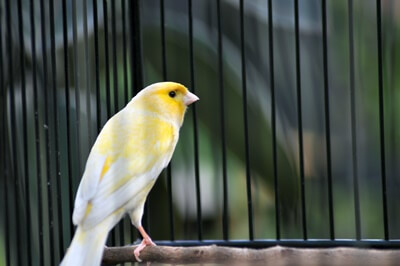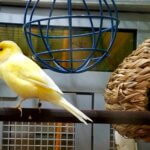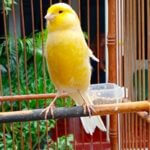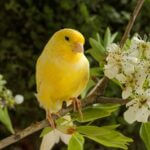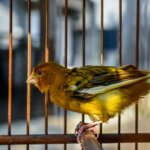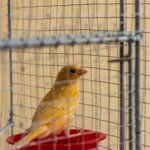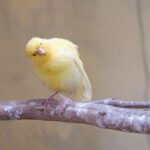Air sac mites are most commonly transmitted through beak-to-beak contact when mother canaries feed their young and sometimes during mating.
In situations where two or more canaries live together in enclosed spaces, transmission occurs when an infected canary coughs or sneezes. This releases tiny air sac mites, which are inhaled by other canaries.
The Brazilian Journal Of Veterinary Parasitology shows a much higher rate of air sac mite infections in captive birds than in wild birds.
Canaries can recover from air sac mites if the problem is detected and treated sufficiently early.
What Are Air Sac Mites?
Air sac mites (Sternostoma tracheacolum) are tiny parasites that can live in the respiratory tracts of avian species like canaries. They mainly attack the following:
- Lungs
- Trachea
- Syrinx
- Air sacs
Canaries have 9 individual air sacs in addition to their lungs. That’s what makes their respiratory systems so effective, but they’re also vulnerable to toxic air or infections by parasites.
According to the New Zealand Veterinary Journal, the first case of an air sac mite infection in a canary was recorded in South Africa in 1948.
Like many organisms, air sac mites consist of male and female pairs. The females grow to around 0.7mm, while the males grow to around 0.4 mm.
According to Experimental & Applied Acarology, female mites are responsible for most symptoms of infection, such as labored breathing.
Diagnosing Air Sac Mite Infections
A necropsy is the most common way of detecting the presence of air sac mites in canaries.
That’s because early detection is extremely difficult, as most canaries don’t manifest signs of infection until they’re extremely sick or have died.
However, there are ways to detect air sac mites in canaries.
Swabbing
Tracheal swabs are more invasive on canaries and small birds but provide more conclusive results.
Oropharyngeal swabs are more comfortable, so they’re more commonly used. They usually show advanced infections since they only collect samples from the mouth and throat.
After collecting swabs, your vet will put the tissues under a microscope for examination.
Trachea Examination
A vet may examine the trachea to determine if a canary is infected with mites. This is commonly done by wetting the trachea with alcohol and transilluminating the area in a dark room.
The presence of many tiny black spots is a sure sign of infection. According to Watchbird, air sac mites often turn darker after feeding on their hosts’ blood.
Symptoms of Air Sac Mite Infection in Canaries
The life cycle of air sac mites is short, going from larvae to full-grown adults in less than 6 days.
If your canary is infected, you’ll observe the following signs:
Shortness of Breath
When the canary’s trachea and air sacs are teeming with parasites, their ability to function properly is compromised. The canary won’t be able to hold the amount of air it’s supposed to.
So, the canary will periodically have breathing difficulties, with most birds tending to open their beaks and hold them up to inhale more air.
Lethargy
As the mites affect the canary’s ability to breathe and hold oxygen, the bird will avoid movement that may increase its need for oxygen. For instance, it may avoid flying around its cage.
A canary with a moderate-to-advanced infection will stay huddled in the corner of its cage.
Shorter Flights
If the canary has been flying all around the house and in its cage, the presence of mites in its air sacs and lungs will make it laborious for the canary to fly, so it may avoid flying completely.
Most pet canaries don’t fly much, so you’re unlikely to notice this symptom.
However, if the canary suddenly stops flying and exhibits the other highlighted symptoms, it should be clear that air sac mites are behind the problem.
Sneezing And Coughing
If your canary has air sac mites, it’ll constantly be coughing and sneezing in a subconscious attempt to get rid of any parasites in its trachea.
To be sure the coughing and sneezing are caused by air sac mites, be on the lookout for the following:
- Wheezing
- High-pitched noises
- Squeaks
If you hear these sounds when the canary is coughing or breathing, it’s likely to be infected.
Reduced Singing
Canaries are known and loved for their singing abilities. However, air sac mites in their respiratory tracts can keep them quiet.
Even when the canary doesn’t stop singing, an infection will cause them to make squeaky noises when it sings. It’ll often stop at regular intervals to gasp for air.
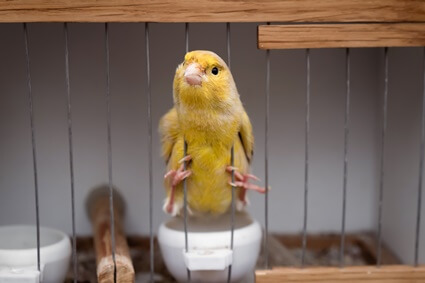
Sudden End To The Reproductive Cycle
An infected canary will stop laying eggs once the infection reaches a certain point. Conversely, a male seeking a mate will suddenly halt its search and spend time huddled in its cage.
Other possible symptoms include:
- Weight loss
- Wet and dripping mouth and nostrils
- Fluffed-up appearance
- Overall weakness
The above signs of air sac mites are almost identical to other respiratory illnesses affecting canaries.
Treating Air Sac Mites in Canaries
There are three ways to treat or manage air sac mite infections in canaries.
Treating an Individual Canary
If you only own one canary, treatment is a straightforward affair. You only need to:
- Take the canary out of its cage and into a new “treatment cage.”
- Apply ivermectin topical treatment (undiluted) to the neck of the canary for 5-7 consecutive days.
- Add some Ivermectin or S76 into the canary’s drinking water and dilute as directed.
Depending on the level of infection, you can use energy and vitamin supplements, such as:
- NV powder
- Turbobooster
- Quik Gel
- Thrive
These should also be mixed in the drinking water. After that:
- Repeat the Ivermectin treatment after 2 weeks if you still notice signs of infection.
- Before returning the canary to its cage, clean it and spray an avian-friendly pyrethrin disinfectant.
- Choose Coopex, F10 CL, or AIL to kill any mites in the cage.
Flock Treatment
You should administer treatments to all birds once you notice signs of infection in one of them. The other canaries don’t need to be visibly sick for you to proceed.
Treatment involves the following steps:
- Remove the visibly sick canaries and quarantine them.
- Remove the remaining birds from the cage and disinfect them with AIL, Coopex, or any avian disinfectant spray.
- Give the sick canaries the ivermectin (or moxidectin) treatment for 5 days. This should involve both the tropical treatment and the oral dosage.
- Give the rest of the canaries the oral treatment for 3 consecutive days.
- Repeat the 3-day treatment on all canaries every week (after 6 days) for 3 weeks.
This will ensure you target the mites at the end of their life cycles.
Preventative Treatment
Preventative treatment involves taking measures to ensure your canary doesn’t get infected with air sac mites. Even if it does, the infection won’t be as severe.
Administer Ivermectin during the hot seasons and when the canary is molting.
These two periods are usually stressful for canaries, and the stress can lower their immunity, making it hard for them to battle infections.
- The treatments should go for about 3 consecutive days followed by a 6-7 day break.
- Repeat this for 3 weeks.
- Regularly spray the canary’s cage and bedding with disinfectant sprays.
- Ensure that your canary gets all the nutrients it needs, whether in its diet or supplements, so it maintains a robust immune system.
The immune systems of captive canaries are almost always weaker than wild canaries. This is mostly due to poor nutrition and hygiene since most canary owners are unaware of proper diet and hygiene practices. Boost your canary’s immune system, so it’s less likely to fall victim to this infection.

